Issues You Should Know About Before Growing An Indoor Pothos
Pothos are famed for their beauty, ability to live in low-light conditions, and being suitable beginner plants. Also known as Devil's Ivy, Pothos comes in several variegation patterns and colors, making them perfect for nearly anyone. Even better, they're vining plants, so they look marvelous whether they're growing on a trellis, hanging from a pot, or cascading along a wall. There are very few downsides to this popular variety, but there are a few things to remember before growing an indoor pothos.
Despite their low-maintenance qualities, it's still crucial to provide your pothos with the proper care. Like any houseplant, they require a specific amount of water, light, and fertilizer and can be affected by pests or diseases. Thankfully, as long as you know the signs to look out for, you can fix the issue and help your plant thrive again. Here are some common pothos problems along with their signs and solutions.
The leaves are turning yellow
If your pothos leaves start to yellow, it can be due to overwatering or underwatering. Overwatering your plants is a common issue, so if your pothos leaves turn yellow, it may be a sign to hold back. On the other hand, if it's been a few weeks and the soil is dry, it may indicate that your pothos is thirsty. To ensure you're giving your plant the proper amount of water, test first, either with your finger or a moisture meter.
Water gauges are one of the best houseplant tools, and they're easy to use. All you need to do is stick it into the soil about ⅘ of the way down, wait 30 to 60 seconds, and read the meter. You only need to water your pothos when the gauge shows the soil is on the dry end. If you don't have a moisture meter, you can just use your finger to check the soil. If the top inch feels dry, it's time to water.
Even if you are watering properly, it's still possible your plant has root rot. This happens when the roots sit in water for too long. Aside from overwatering, root rot can occur if you don't have well-draining soil or if your pothos is in a pot without drainage holes.
Brown spots are appearing on your pothos
Brown spots may indicate a few issues, though there are two that are most common. You may be overwatering your plant or placing your pothos in too direct of sunlight. Pothos do best in medium to bright indirect light. Like humans, plants can get sunburnt in the form of brown spots. In extreme situations, you may even notice small holes in the leaves that have a crisp brown perimeter. If you have your pothos in bright, direct lighting, try moving it to a space with a bit more shade.
Overwatering can also cause brown spots on pothos leaves, so make sure you are only watering when the soil is dry. Like other houseplants, pothos would prefer to be too dry than to be waterlogged. Once your pothos are in proper lighting and receiving adequate water, check the leaves to ensure the issue is resolved and no new brown spots appear. However, any current brown areas on the leaves won't go away. If any of your leaves have significant amounts of brown on them, cut them off. By removing unhealthy leaves, your plant can focus on producing healthy green leaves.
There are brown edges on the leaves
Like other common pothos issues, brown tips may be due to improper watering. When the plant lacks moisture, the leaves will die off, starting at the tips. If you feel confident you have a good watering schedule, it could be an issue with the soil. Perhaps you recently repotted your pothos and now notice there are yellow and brown leaves appearing out of nowhere. In this case, check the type of soil you purchased to ensure it's the right type for your plant.
Pothos roots require air, and if they're submerged in soggy soil, they may become damaged. Ironically, because of this, overwatering can cause your pothos to struggle to get water. It'll be unable to absorb and transport the water properly, resulting in the tips turning brown. Make sure you plant or repot your pothos in well-draining, nutrient-rich soil. Devil's Ivy thrives in slightly acidic soil, ranging from 6.1-6.8pH, which is where most potting products fall. Lastly, make sure your pot has drainage holes so excess water has somewhere to escape during watering sessions.
Pothos with wilted or curled leaves
If your pothos leaves are starting to wilt or curl, this is a sign your pothos needs a drink of water. When a pothos doesn't get enough water, the leaves will begin to curl to retain moisture. Once you give your plant a good watering, the leaves should perk up within a few hours. Alternatively, if you've watered recently and the leaves are still curling or droopy, it could be due to overwatering or temperature shock.
Pothos are tropical plants that thrive in temperatures in the range of 65-85 degrees Fahrenheit. If your plant is in a range outside of this temperature, it could cause stress. Consider the placement of your pothos in your home. Is it near a window or an air conditioning unit? If so, move it to an area where the plant isn't getting directly hit by cold air.
Another possible culprit for curled leaves is bacterial wilt, another disease that affects pothos. You'll know your pothos have this condition if the leaf veins appear black in addition to being wilted. Unfortunately, in this case, you'll have to dispose of the full plant and soil to avoid spreading it to other plants.
The vines are elongated or leggy
When you got your pothos, it was bushy and full, and now it seems like there are more vines than leaves. In this case, it could be due to one of three issues. Your pothos may not be receiving enough sunlight, it wants to climb, or it's getting too much fertilizer. In shady conditions, vining plants like pothos will stretch out in an attempt to find more light. In this case, the plant will spend its energy on stem growth rather than leaf growth. While pothos can withstand low lighting, they thrive in indirect bright light. If you don't have enough natural sunlight coming in, consider purchasing a grow light to supplement.
Fertilizer is essential for plant growth, but there is such a thing as too much of a good thing, even with plant food. If you fertilize your pothos too frequently, it will cause abnormally fast growth and push out more vines. However, pothos are climbing plants, so they naturally seek supports to attach to. The vines will continue to grow in search of something to grab, causing the space between each leaf node to lengthen. One of the best methods to tackle a leggy pothos is to cut off the long vines and propagate your pothos plant.
There's a lack of variegation
Variegated pothos are beautiful, but the leaves will revert back if the plant isn't in the proper conditions. The main issue that leads to reduced variegation is a lack of sunlight. Although Epipremnum typically does okay in low or medium lighting, variegated plants require a little bit more sun. Because variegated pothos lack chlorophyll, they will be less tolerant of insufficient lighting compared to other varieties. So, it's crucial to place these in bright, indirect light to keep the foliage looking radiant.
On the other hand, the issue could be due to the minerals in your water. You may need to switch the water you're using if your pothos leaves have crispy edges in addition to lack of variegation. Rather than using tap water that may have chemicals or minerals, opt for distilled water or rainwater. Once you tackle the issue, you can remove the reverted leaves to prevent them from taking over your pothos.
You've noticed stunted growth in your pothos
Stunted growth in pothos is one of the most common issues because there are so many potential causes. If you feel confident your plant is in proper light and getting the right amount of water, other factors could be at play. If it's been a while since you've fertilized your plant, your pothos may need more nutrients to start growing again. It's also possible your plant is slowing down in cooler months, which is completely normal.
Assuming there are no other issues and your pothos are in proper conditions, it may be time to repot your plant. This solves two issues that can contribute to stunted growth: being root-bound and nutrient issues. Plants don't just get nutrients from fertilizer but get their needs met by absorbing nutrients from the soil. On average, you should repot your pothos every year or two in nutrient-rich soil. However, you should also move up sizes when your plant is root-bound. You'll know it's time to give your roots more room for growth if they're tightly wound or are growing out of the drainage holes. When it's time to go up a size, aim for a pot that's about two inches wider than the current mass of roots.
Pests on your pothos
Sometimes, pothos can be in perfect living conditions and still have issues with pests, some of which can be unnoticeable to the naked eye. To keep pests at bay, regularly check your houseplants with a magnifying glass and note any changes. The most common pests that plague pothos are mealybugs and scales.
If you notice white, fluffy patches on your plant, these are likely mealybugs. To remove these, use a cloth with rubbing alcohol to wipe them off. You can also place some rubbing alcohol in a spray bottle and spray your plant to kill off any remaining bugs.
Scales are pests that attach themselves to the leaves and stems and drain the plant of sap. They are immobile and look more like bumps than bugs. So, it can be hard to spot them meaning an infestation can grow rapidly unnoticed. If you spot any odd bumps on your pothos, quarantine your plant until you rule out a scale infestation. Like with mealybugs, use an alcohol wipe to remove them gently. You'll need to eliminate them all to prevent spreading. For larger infestations, you're better off disposing of your pothos to prevent them from spreading to other houseplants.








